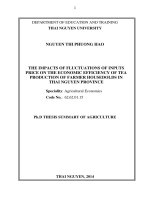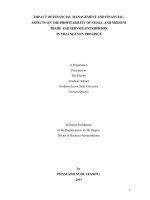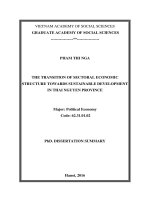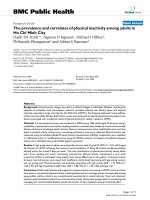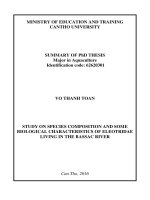The prevalence and some associated factors of silicosis among employees working in one factory in Thai Nguyen province, 2020
Bạn đang xem bản rút gọn của tài liệu. Xem và tải ngay bản đầy đủ của tài liệu tại đây (464.33 KB, 73 trang )
MINISTR Y OF EDUC ATION A ND TR AINI NG
MINISTR Y OF HEAL TH
HANOI MEDICAL UNIVERSITY
DIETARY INTAKE AND PHYSICAL ACTIVITY
OF ELEMENTARY SC HOOL CHILDREN
IN HA NAM AND DIEN BIEN PROVINCES IN 2020
Major
: Doctor of Preventive Medicine
Major code : D720302
THESIS OF GRADUATION MEDIC AL DOCTOR
COURSE 2015-2021
Supervisor:
I. Assoc. Prof. PhD. Tran Thuy Nga
2. Assoc. Prof. PhD. Pham Van Phu
HANOI-2021
r-u -ÍM Qỉ ugc V
Hl
ACKNO WLED GEM ENTS
Six years studying in Doctor of Preventive Medicine Program of Hanoi Medical
University (HMU) was an unforgettable experience in my life. Nutrition is a
challenging field, and it presented many difficulties to me when I decided to do my
thesis on it But. as a result of it. I did not only gain more knowledge, but also more
skills. The implementation would not be possible if I did not receive the assistance of
several individuals and organizations Thus. I would like to express my sincere gratitude
to all of them even though it is impossible to list them all
First and foremost, I would like to express my heartfelt gratitude and appreciation to Assoc. Prof. Tran ThuyNga, head of Department of Micronutrients, National
Institute of Nutrition, for her invaluable guidance, relentless encouragement, expert
suggestions, constructive criticism, and supervision, all of which were essential in
completing this thesis.
I am thankfol to Assoc. Prof Pham Van Phu from the Department of Nutrition.
Institute for Preventive Medicine and Public Health for his great interest, encouragement. supervision. and helpfol advice on thesis progress.
I would like to express my deepest thanks to the Managing Board. Department
of Training. Hanoi Medical University who had created a welcoming and wonderfol
environment in the school for the past six years. I wish to thank all the teachers in the
Department of Nutrition. Institute for Preventive Medicine and Public Health. Hanoi
Medical University for their valuable information provided by them in their respective
fields. I am grateful for their cooperation during the period of my assignment.
Finally. I would like to thank my wonderful family and friends for their unwavering support during this ordeal. Your unwavering love and support gave me the
strength to keep going
Hanoi. 2021
Duong Tmng Due
-ÍM CỊỈ ugc V
Hl
DECLARATION
I declare that this thesis represents my own work and has not been submitted for
any degree in any university previously. All the sources of information which have
been use in the thesis and external contribution are fully referenced and acknowledged
Hanoi. 2021
Duong Trung Due
r-u -ÍM Qỉ ugc V
Hl
TABLE OF CONTENT
INTRODU CTION.........................................................................................................1
CHAPTE R 1: LITERATURE RE VIEW......................................................................3
1.1. Dietan' intake.....................................................................................................3
1.1.1 Definition of dietary intake...........................................................................3
1.1.2. Methods of dietary intake assessment........................................................ 3
1.1.3. Recommended dietary allowances for elementary school children...........6
1.2. Physical activity................................................................................................ 9
1.2.1 Definition of physical activity......................................................................9
1.2.2. Methods of assessing physical activity.................................................... 10
1.2.3 Recommendations on physical activity for elementary school children. 13
1.3. Previous studies on dietary intake and physical activity of elementary school
children.................................................................................................................... 15
1.3.1 In the world................................................................................................ 15
1.3.2. In Vietnam................................................................................................ 17
CHAPTE R 2: RESEA RCH su BJECT SAND METH ODOLO GY........................ 19
2.1. Study subjects:................................................................................................ 19
2.1.1 Inclusion criteria:....................................................................................... 19
2.1.2. Exclusion criteria:.................................................................................... 19
2.2. Study time and study sites ..............................................................................19
2.3. Methodology....................................................................................................19
2.3.1. Study design:............................................................................................ 19
2.3.2. Sampling...................................................................................................19
2.3.
Variables and indicators...................................................................................21
2.4.
Data collection................................................................................................ 22
2.5.
Potential errors and solutions...........................................................................23
2.5.1 Potential errors.......................................................................................... 23
2.5.2. Solutions...................................................................................................23
2.6.
Data management and analysis........................................................................24
2.7.
Ethical issues....................................................................................................24
CHAPTE R 3: RESULTS............................................................................................ 25
3 1. Characteristics of research subjects......................................................................... 25
3.2.
Dietary intake of research subjects...................................................................26
3.3.
Ph ysical activity of research subjects............................................................. 40
CHAPTE R 4: DISCUSSION......................................................................................4S
4.1. Dietan- intake of the research subjects................................................................. 4S
4 2. Ph ysical activity of the research subjects............................................................... 53
CONCLU SION...........................................................................................................58
1. Dietary intake of the elementary school children in Ha Nam and Dien Bien
province in 2020........................................................................................................ 58
2. Physical activity of the elementary' school children in Ha Nam and Dien Bien
r-u -ÍM CỊỈ ugc V
Hl
province in 2020...........................................................................................................58
RECOMMENDATIONS............................................................................................. 59
REFERE NCES
APPENDIX
r-u -ÍM CỊỈ ugc V
Hl
LIST OF ABBREVIATIONS
24HR
FFQ
MVPA
24-hours Dietary Recall
N IN-
Moderate to Vigorous Physical Activity
PA
National Institute of Nutrition
RDA
WHO
Food Frequency Questionnaire
Physical Activity
Recommended Dietary Allowances World Health Organization
r-u -ÍM Qỉ ugc V
Hl
LIST OF TABLES
Table 3. 1 Demographic characteristics of the students...............................................25
Table 3.2 Food consumption of students by province..................................................26
Table 3. 3 Energy and macronutrients intake by province...........................................27
Table 3 4 Micronutrients intake of the students by province........................................28
Table 3 5 Food consumption of students by gender.....................................................32
Table 3 6 Energy and macronutrients intake by gender............................................. 33
Table 3 7 Micronutrients intake of students by gender ................................................34
Table 3 s The proportion of protein and lipid intake by province and gender............39
Table 3. 9 Average of PAQ score of students by province and gender.........................40
Table 3 .10 Lex el of physical activity of students by proxince.................................. 40
Table 3.11 Lex el of physical activity of students by gender........................................41
Table 3. 12 Frequency of students engaging in moderate to vigorous physical
activity for at least 60 minutes each day in the last 7 days by province41
Table 3. 13 Frequency of students engaging in moderate to vigorous physical
activity for at least 60 minutes each day in the last 7 days by gender .42
Table 3 14 Actixities students attending in die past 7 days by province......................43
Table 3 15 Proportion of children cycling or xx’alking to school by prox-ince......... 44
Table 3 16 Actixities children doing during school break-time by gender..................44
Table 3 17 Mean time children doing sedentary activities by province.......................45
Table 3.18 Mean time children do sedentary actixities by gender.............................. 46
Table 3 .19 Electronic device students use most often by province............................ 46
Table 3.20 Ax erage evening sleeping time of students by province and gender........47
LIST OF FIGURES
Figure 3. I Proportion of energy and macronutrients meeting RDA by province. ...30
Figure 3. 2 Proportion of micronutrients meeting the RD A by province...................31
Figure 3. 3 Proportion of energy and macronutrients meeting the RDAbv gender. 36
Figure 3. 4 Proportion of micronutrients meeting the RD A by gender........................37
Figure 3. 5 The balance of energy substances intake of students by province............3S
Figure 3. 6 The balance of energy substances intake of students by gender............... 39
DIETARY INTAKE AND PH YSICAL ACTIVITY OF ELEMENTARY
SCHOOL CHILDREN IN HA NAM AND DIEN BIEN PROVINCES IN 2020
ABSTRACT
Background & objectives: Dietary intake and physical activity (PA) are not only
directly affected to children's growth, but also indirectly affected to their cognitive
abilities and stature development. This study aims to describe the dietary intake and
assess the PA of elementary school children
Methods: A cross-sectional study involved 248 students aged 7-10 years in Ha Nam
and. Dien Bien provinces from October to November 2020. In which. 225 dietary
intakes were collected by 24-hours dietary recall method. The PAQ questionnaire was
used to assess the students’ PA
Results: The mean energy consumption is under the RDA (1367.6 = 5ỐS.1 Kcal). Total
pro-tein consumption is high (143.9% of the RDA). Lipid and carbohydrate are not
meeting the RDA Calcium, magnesium, vitamin Bl. B2, B6. folate, vitamin A. D are
under the RDA. The energy-generating substance structure is balanced (P:L:C=16
4:23.4.60.2). The average PAQ score is 2.9 = 0.6 points. Hie majority of students are
moderate-active (81.8%). whereas 18.2% are low-active. Students spend an average of
1.2 -1.8 hours on sedentary activities even- day Students in Ha Nam spend more time
on sedentary activities than students in Dien Bien
Conclusion: The dietary intake of elementary school children aged 7-10 years in Ha
Nam and Dien Bien did not meet the RDA for energy, lipid, carbohydrate and some
micronutrients However, the composition of macronutrients reached the RDA Majority
of students are moderate active.
Keywords: dietary intake, physical activity , elementary school children, Ha Nam, Dien
Bien.
-c -ÍM Qỉ ugc V Hl
1
INTRODUCTION
Dietan- intake plays an important role in nutritional status and people’s health A
healthy diet is considered crucial for elementary school children It does not only
directly affect to their growth, but also indirectly affect to children’s cognitive abilities
and learning results (1) Several studies around the world found that multiple dietary
inadequacies are frequent among children from developing countries [2]. [3]. In
Vietnam, a study by Tran Khanh Van et al in 2017 conducted in Thai Nguyen province
found that the dietary intake of elementary school students aged 7 to 10 years did not
meet the recommended dietary allowances of the National Institute of Nutrition in
terms of both energy and proportion of macronutrients, the study also found the lack of
micronutrients in the diet [4], Lack or excess nutrients in primary school children all
leads to nutritional disorders such as malnutrition and micronutrient deficiency
Nutritional disorders are thought to be caused mostly by an inadequate diet [5]
In addition to a healthy diet, children will benefit from a regular schedule of
physical activity. The role of physical activity in normal growth and development is
obvious. Increased physical activity, especially at school age. aids in optimal height and
stature development [6] Furthermore, several studies around the world have shown that
physical activity can help minimize the risk of cardiovascular disease, metabolic
disease, aid mental disorders [7], (8).
However, several studies around the world and in Vietnam have shown that the
proportion of students who meet the recommendations of physical activity is still low.
According to study conducted by Zimmo L et al in 2017. only 39% of primary school
students in Qatar engaged in moderate to extreme physical activity for 30 minutes or
more a day students spend an average of 58.1% of their dailytime on sedentary
activities [9] In Vietnam. 2016. Do Van Dung et al. conducted a study on 619 grade 5
students in Ho Chi Minh City, finding that 18% of students did not engage in physical
activity, male students are more active than female students, and sedentaty activities are
r-u -ÍM Qỉ ugc V
Hl
2
common in both genders (10]
Adequate diet and physical activity are the prerequisites for children’s growth.
Economic growth also contributes to social changes, including changes in children’s
eating and exercise behaviors. As a result, many countries around the world are
interested in studying children's dietan’ intake and physical activity It provides a
scientific basis for the government to establish interventional strategies and other health
strategies to improve children's health However, in Vietnam, studies on elementary
school children's dietary intake and physical activity are still not really interested. For
the above reasons, we conduct the research ••Dietary intake and physical activity of
elementary school children in Ha Nam and Dien Bien provinces in 2020” with two
following objectives:
1 To describe the dietary intake of elementary school children in Ha Nani and Dien
Bien provinces in 2020
2 To assess the physical activity of elementary' school children in Ha Nani and Dien
Bien provinces in 2020
-ÍM Qỉ ugc V
Hl
3
CHAPTER 1: LITERATURE REVIEW
1.1. Dietary intake
1.1.1. Definition of dietary intake
Dietan’ intake is the amount of food consumed in one day to fulfill the body’s
energy and nutrient requirements [11]
The per-subject intake was determined by the amount of meals consumed per
day. the distribution of meals at different times of the day taking into consideration meal
timing, and a balanced distribution of energy ratios among meals [11].
1.1.2. Methods of dietary intake assessment
Dietan' assessment is an evaluation of food and nutrient intake and dietary
pattern of an individual or individuals in the household or population group over time It
is one of the four approaches in nutrition assessment to evaluating the nutritional status
of individuals comprehensively. The other three are anthropometries, biochemical
parameters and clinical examination [12].
Dietary intake can be assessed by subjective report and objective observation
Subjective assessment is possible using open-ended surveys such as dietary recalls or
records or using closed-ended surveys including food frequency questionnaires Each
method has inherent strengths and limitations Subjective dietary assessment methods
that assess an individual's intake include the 24-hour dietar.' recall (24HR). dietar.record (DR), dietary history, and FFQ. Data are collected with the help of a trained
interviewer or by self-report [13].
24-hours dietan- recall (24HR)
The 24HR is conducted in an in-depth interview manner and typically requires
20 to 30 minutes to complete a single day recall Subjects are asked to report all foods
and beverages consumed in the past 24 hours This can be done via telephone or face-toface interview. Trained staff must conduct the interview to prompt for details, such as
cooking methods and portion sizes [2]. (4]
Detailed data about food preparation methods, ingredients used in mixed dishes,
and the brand name of commerc ial products may be required according to the research
question The amounts of each food consumed are estimated in reference to a common
-c -ÍM
-u ■<:
4
size container (e.g.. bowls, cups, and glasses), standard measuring cups and spoons, a
three-dimensional food model, or two-dimensional aids such as photographs One
advantage of the 24HR is that a relatively minimal burden is imposed on respondents
However an inevitable limitation is that all information depends on the respondents'
memory and the skills of a well-trained interviewer to minimize recall bias [11]. [13].
Another limitation is that this method is mainly focused on short-term intake,
but long-temi dietary exposure is especially of interest when investigating chronic
diseases. Thus, to measure average intake, multiple 24HRs are needed Repeated
measurement not only requires a lot of resources and time, but survey repetition can
also influence a respondents' diet. A further disadvantage is from the open-ended
format, which requires significant effort during data collection, entry and analysis. The
research team must carefully renew each questionnaire to ensure that all recorded data
is included. After initial review, all foods and mixed dishes consumed according to the
detailed descriptions of the respondents should be matched and coded with the most
appropriate food listed in the food composition database Moreover the quantity’ of food
consumed should be converted to its actual weights When the reported information is
changed to the corresponding food code and weight, actual intakes can be calculated
[11], [13]
Dietary record
Subjects record all food and beverages consumed over three consecutive days
(two weekday’s and one weekend day). The consumed items can be measured using a
scale or other household items, such as measuring cups or spoons, or estimated using a
portion-size guide. Trained staff must provide detailed instructions on how to record
intake (15]
The main advantage of dietary record is its potential to collect accurate quantitative information on individual foods consumed during the registration period.
Because of the quality of the dietary data, the dietary record is considered to be the gold
standard of the dietar,’ methods and is often used as a reference in calibration or
validation studies using other less involved and less expensive methods The weighted
dietary record provides more precise estimates of intakes for individuals which can be
r-u -ÍM Qỉ ugc V
Hl
5
related to health indices, such as nutritional status measured by blood analytes. As foods
are recorded as consumed, it is less likely to omit forget food items and moreover, the
description thereof is more accurate. When the dietary record uses open-ended
questions, abundant information can be collected and analyzed in various aspects. For
example, if sufficient das's are recorded, day-to-day variation can be studied. Also,
detailed descriptions of the foods consumed, and all eating occasions are prosided It can
be easily applied to diverse groups with a wide range of eating habits and may be used
to estimate the average intake of a certain population since provides excellent estimates
for energy, nutrients, foods and food groups. Dietary record is suitable in metabolic and
in tervention studies (13). (16)
Since the diet varies greatly from day to day. the reported data can only represent the current diet, not the normal diet. However, if the procedure is repeated, the
usual intake may be calculated. Those who may fill out dietary record (interviewees or
caregivers) must be both inspired and literate (if done on paper), which can restrict their
use in certain populations (people with low literacy, immigrants with low language
skills, children, elderly, people with difficulty writing ....). Because the DR require high
cooperation limits the type of population that can be applied and this could compromise
the generalizability of the results to the wider population [13], [16]
Dietary history
r-u -ÍM Qỉ ugc V
Hl
6
To assess individual long-temi dietary intake. Burke developed a dietary history
method in 1947 [17] This method requires that subjects complete a 24HR 3’ day food
diary, and checklist of foods usually consumed Highly skilled professionals arc required
to collect information on tile participant’s usual diet using an in- depth interview
(approximately 90 minutes to complete). Thus, this method is rarely used in
epidemiological studies [13], [17]
Food frequency questionnaire (FFQ)
The FFQ is an advanced form of the checklist in dietary history method and asks
respondents how often and how much food they ate over a specific period. Presenting
about 100 to 150 foods, this questionnaire takes 20-30 minutes to complete and can be
self-administered or collected via interview. This method enables the assessment of
long-term dietary intakes in a relatively simple, cost-effective, and time-ìcient
manner Thus, various FFQs have been widely employed as a practical instrument since
the 1990s FFQs should be developed specifically for each study group and research
purposes because diet may be influenced by ethnicity, culture, an individual's
preference, economic status, etc (11], [13]
1.1.3. Recommended dietary allowances for elementary school children
The Food and Nutrition Board of the US National Academy of Sciences defines
The Recommended Dietary' Allowance (RDA) is the average daily dietary’ intake level
that is sufficient to meet the nutrient requirements of nearly all (97 to 9S percent)
healthy individuals in a specific life stage and gender group The RDA is intended
primarily for use as a goal for daily intake by individuals [IS],
1.1.3.1. Requirements of energy, proteins, fat and carbohydrates
Children need energy on a daily basis for basic metabolism, physical activity, cell
development and lifespan. Food is an energy source. The three main macronutrients in
the body are carbohydrates, proteins, and lipids. The kilocalorie is the unit for
measuring energy purity (Kcal) [IS], Primary school children aged 6 to 11 years old.
according to the National Institute of Nutrition need between 1270 and 2400 Kcal per
day to meet their body’s growth and development [19]
Protein has been described as the most crucial material or factor in the creation of
7
life. Protein assists in the creation, maintenance, and repaữ of body tissues. It is
especially important for a child's growth. Meat. fish, poultry, milk, and milk products
are all good sources of protein for children Protein requirements depending on age.
gender, physiological status, and medical issue Protein RDAs for elementary school
children range from 33 to 50 grams per person per day Protein can account for 20-30%
of dietan' energy at this age. with animal protein accounting for 50% of that [19], [20]
Lipid is a common organic compound present in plant and animal cells. It can be
found in butter, fat. oil. milk. meat, and other foods. Lipid is known to be an important
component of food It provides more than twice the amount of energy as protein and
carbohydrates (about 9 kcal 1 gram of lipids). Furthermore, lipid is a canier of lipidsoluble nutrients including vitamin A. D E. K The body’s ability to absorb lipids
determines the biological value of fat-soluble substances. According to the RDA for
Vietnamese, the lipid requirement for children aged 6 to 11 years is 32-72g per person
per day, with lipids contributing for 20-30% of total energy. Arachidonic acid, a poly unsaturated fatty acid found in animal fat. is essential for the rapidly developing
children's body, so the ratio between animal lipids and vegetable lipids is recommended
at 70% and 30% respectively [19]. [20].
Carbohydrate which includes staple foods, sugars, and fiber, are the most essential ingredient accounting for the majority of meal volume. It is also the body's main
source of energy (1 gram of carbohydrates provides 4 kcal) The body's main energy
supply is food. Carbohydrates contribute to shaping and controlling body movements,
as well as being a source of fiber. According to the RDAs for Vietnamese. primary'
school children's carbohydrate requirement ranges from 210 to
r-u -ÍM Qỉ ugc V
Hl
8
-c -ÍM Qỉ ugc V Hl
9
This term therefore includes the full range of human movement from competitive
sport and exercise to hobbies or activities involved in daily living Conversely, physical
inactivity can be described as “a state in which bodily movement is minimal and energy
expenditure approximates the resting metabolic rate" (26 ].
Physical activity is a complex, multi- dimensional behavior. Many different
modes of activity contribute to total physical activity; these include occupational
household (e.g. caregiving, domestic cleaning), transport (e.g. walking or cycling to
work) and leisure- time activities (e.g. dancing, swimming) Exercise is a subcategory of
leisure- time physical activity and is defined as "physical activity in which planned,
structured and repetitive bodily movements are performed to improve or maintain one
or more components of physical fitness" [26], [27]
Physical activity can be classified further according to its frequency, duration.
and intensity The frequency and duration of an activity refer to how frequently and for
how long it is done. The amount of energy expenditure that an activity necessarily
requires is referred to as intensity (26)
1.2.2. Methods of assessing physical activity
Physical activity is a multifaceted behavior that can be assessed in. a range of
methods. For measuring energy expenditure and. more precisely, physical activity, a
variety of instruments are available, including objective and self-reporting methods
Both physical activity' and inactivity (sedentary behavior such as sitting or television
viewing) can be measured using these methods [26]. [2S]
Self Report Questionnaires
These questionnaires are the most common method of PA assessment [29] and
rely on participants' recall ability. Questionnaires vary by what they measure (eg., mode. duration, or frequency of PA): how data are reported (eg.. activityscores. time,
calories), quality of the data (eg.. measures of intensity differentiating between habitual
and merely recent activities inclusion of leisure and non-leisure activity), and how data
are obtained (e g., paper and pencil assessment, computerized questionnaire, interview)
[30]
Their advantages include cost effectiveness, ease of administration, and ac-
.Tin
-u ■<:
1
0
curacy in. measuring intense activity, determining discrete categories of activity level
(eg., low, moderate, high), ranking individuals or groups in their PA providing details
about the PA. and showing improvement across groups or individuals Potential
disadvantages are that self-report questionnaires are less robust in measuring light or
moderate activity, assessing energy expenditure and may be limited by the dependency
on written language (j e.. questions) and external factors (i.e.. social desirability,
complexity of the questionnaire, age. and seasonal variation). Self-report questionnaữes
are significantly more reliable at the group than the individual level as well as when the
questionnaire is structured chronologically and with discrete periods [26], [28], [31].
Self-Report Activity Diaries Logs
Self-report diaries require participants to record PA in real time which provides
the most detailed data and can overcome some limitations of questionnaữes (i.e., less
susceptible to recall errors, social desirability bias, measurement bias) To illustrate.
Bouchard's Physical Activity Record (BAR) is a widely used diary in which participants
report PA for each 15-minute interval over three days. Activities are rated on a scale of
1 to 9 (1 = sedentary activity, 9 = intense manual work or high intensity sports) to yield
a total ener gy expenditure score; however, the diary is burdensome, particularly for
individuals with cognitive dysiunction. In addition, questionnaires not completed in real
time could be subject to memory bias as well as participant reactivity, the phenomenon
of behavior change due to awareness of beingobserved [28], [30],
Objective methods [28]
Direct Observation
-■c -ÍM CỊỈ ugc
V Hl
1
1
In direct observation an independent observer monitors and records PA This
method of assessment is often used when activity is restricted to a delineated space (eg
a classroom). It is also a popular method for young children as they have difficulty
recalling their PA This flexible method is valuable in gathering contextual infoimation
(eg., preferred location, time, and clothing) and details of the PA (eg., type, personalized
variations to activities). Disadvantages include high cost of time and energy, potential
reactivity, difficulty obtaining ethical approval, and the lack of objective measures of
energy expenditure.
Devices: Accelerometers
In recent decades, accelerometers have gained popularity given their accuracy,
ability to capture large amounts of data, and ease of administration, particularly in large
studies. Accelerometers measure acceleration (counts) in real time and detect movement
in up to three orthogonal planes (anteroposterior, mediolateraL and vertical). These
counts are then translated into a metric of interest, which can be biological (eg energy
expenditure) or PA patterns (e.g. stationary) Devices can be worn in numerous places on
the body, including waist, hip. and thigh
Devices: Pedometers
Pedometers measure the number of steps taken with a horizontal, springsuspended lever arm which is deflected when the subject's hip accelerates vertically
with a force beyond a chosen threshold. Pedometers correlate strongly with uniaxial
accelerometers, and directly observed duration of activities Their simplicity, relatively
low cost, and ability to pick up short durations of PA (often missed by self- report
measures) make these devices popular Pedometer data also tend to be correlated with
biological outcomes and predictors (e g age. BMI) Pedometers appear to yield the most
accurate data for running and moderate walking, as these behaviors require forward
vertical motion
Devices: Heart-Rate Monitors
Heart rate monitoring is a physiological indicator of PA and energy expenditure.
-■c -ÍM Qỉ ugc V
Hl
1
2
providing real-time data on the frequency, duration and intensity 0-f PA in an
unobtrusive (eg. the)' can be worn as watches or on the chest), low-effort way for
periods up to one month HR monitors capture energy expenditure during activities not
involving vertical trunk displacement that many accelerometers and pedometers miss
and are best suited to categorize subjects’ PA levels (Ĩ.C.. highly active, somewhat
active, sedentary) as opposed to the exact amount of PA These devices tend to show
discrepancies particularly at very high and low intensities
-■c -ÍM Qỉ ugc V
Hl
1
3
r-u -ÍM Qỉ ugc V
Hl
1
4
-c -ÍM Qỉ ugc V Hl
1
5
1
6
CHAPTER 2: RESEARCH SUBJECTS AND METHODOLOGY
2.1.
Study subjects:
Students of elementary school in Ha Nam and Dien Bien provinces.
2.1.1. Inclusion criteria:
■ Chi ldren aged 7 10 years at the time of the survey
- Family (caregiver) voluntarily agrees and signs a commitment to participate in
the study
2.1.2. Exclusion criteria:
- Children were away, absent during the study period
- Children with physical and mental deformities affecting anthropometric
- Family (caregiver) with a mental illness could not be interviewed.
- Family (caregiver) did not voluntarily agree to participate in the study
2.2.
Study time and study sites
- Study time: from August 2020 to April 2021.
- Survey time: from October 2020 to February’ 2021
- Study sites. Ha Nam province and Dien Bien province.
2.3.
Methodology
2.3.1. Study design:
This is a cross-sectional study.
2.3.2. Sampling
2.3.2.1. Sample size
Sample size for dietary intake: Using sample size formula to calculate the dietary
intake sample size as follows:
$2
n
- 2(i-
-c -ÍM Qỉ ugc V Hl




